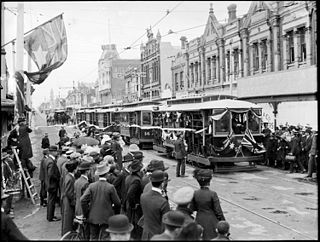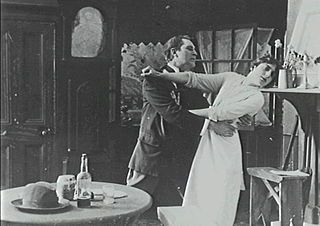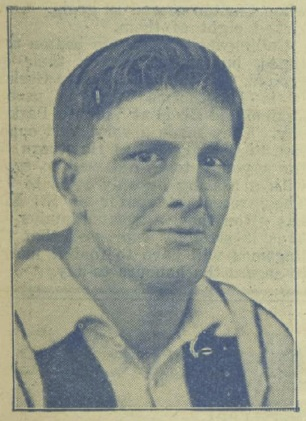Related Research Articles

William Joseph Lincoln was an Australian playwright, theatre manager, film director and screenwriter in the silent era. He produced, directed and/or wrote 23 films between 1911 and 1916.

Godfrey Cass was an Australian actor in the silent era. Between 1906 and 1935 he acted in nineteen film roles. He played Ned Kelly three times, and also had roles in a number of other bushranger movies including A Tale of the Australian Bush (1911) and Moondyne (1913).

The Prahran and Malvern Tramways Trust (PMTT) was a former tram operator in Melbourne, Australia. The trust was formed in 1907, with its first line operating in 1910. Its functions were taken over by the Melbourne & Metropolitan Tramways Board in 1920.

St James the Great, St Kilda East, is an Anglican parish church in the Melbourne suburb of City of Glen Eira in Victoria, Australia.
It Is Never Too Late to Mend is an Australian feature-length silent film written and directed by W. J. Lincoln. It was based on a stage adaptation of the popular 1865 novel It Is Never Too Late to Mend: A Matter-of-Fact Romance by Charles Reade about the corrupt penal system in Australia. It was called "certainly one of the best pictures ever taken in Australia."
The Mystery of the Hansom Cab is an Australian feature-length film directed by W. J. Lincoln based on the popular novel, which had also been adapted into a play. It was one of several films Lincoln made with the Tait family, who had produced The Story of the Kelly Gang.
Rip Van Winkle is a 1912 Australian feature-length film directed by W. J. Lincoln about Rip Van Winkle. It was arguably Australia's first fantasy film.
The Remittance Man is an Australian melodrama film directed by W. J. Lincoln about a thief's reformation.

Transported is an Australian convict melodrama film directed by W. J. Lincoln.
The Road to Ruin is an Australian melodrama film directed by W. J. Lincoln. It was one of the first movies from Lincoln-Cass Films and is considered a lost film.
Lincoln Cass Films was a short-lived Australian film production company.
The Sick Stockrider is a 1913 film directed by W. J. Lincoln based on the 1870 poem of the same title by Adam Lindsay Gordon. It was the first production from Lincoln-Cass Films and is one of the few Australian silent films to survive in its entirety.

The Double Event is a 1911 Australian feature-length film directed by W. J. Lincoln based on the first novel by Nat Gould, which had been adapted several times for the stage, notably by Bland Holt.
The Luck of Roaring Camp is a 1911 Australian feature-length film directed by W. J. Lincoln now considered a lost film. It was highly regarded in its day, in part because it was based on a play that was popular with audiences.
Amalgamated Pictures was a film exchange company in Australia.
After Sundown is a 1911 Australian film directed by W. J. Lincoln set in the Australian bush.

The Prahran Telegraph was a weekly newspaper published from 1860 to 1930 in Prahran, an inner-suburb of the city of Melbourne, Australia. No copy pre-1866 is known to have survived. From 1866 until December 1888, the paper was called the Telegraph and St Kilda, Prahran and South Yarra Guardian. From January 1889 until 7 December 1902, the paper was known simply as the Prahran Telegraph. From 13 December 1902 the banner head read the Prahran Telegraph, with which is incorporated the St Kilda Advertiser and the Malvern Argus.
Robbery Under Arms is a 1907 Australian film based on the popular 1888 novel. It was from the team of J and N Tait and Millard Johnson and W Gibson, who had just made The Story of the Kelly Gang. It is considered a lost film.

Francis Leo Scully was an Australian rules footballer who played with St Kilda in the Victorian Football League (VFL).
The Auditorium was an eight-storey Edwardian building at 167–173 Collins Street, Melbourne, between Swanston and Russell streets, named for its great hall, which was intended for concerts, but was mostly used as a cinema.
References
- ↑ "TAIT'S PICTURES". Table Talk . Melbourne. 20 April 1911. p. 24. Retrieved 26 October 2014– via National Library of Australia.
- ↑ Mary Bateman, 'W. J. Lincoln', Cinema Papers, June–July 1980 p 214
- ↑ "ALONG FILM ROW Folk. Fact and Fancy....The Laughs and Laments of the Trade". Everyones. 3 January 1934. p. 4.
- ↑ "Poverty Point". The Bulletin. 19 June 1924. p. 36.
- ↑ Graham Shirley and Brian Adams, Australian Cinema: The First Eighty Years, Currency Press, 1989, p42
- ↑ Endean, Lin (13 December 1933). "134 Years in the Industry: The Perrys' Record identifier". Everyones. p. 44.
- ↑ Called Back (1911) at IMDb
- ↑ "LIFE & LETTERS". The West Australian . Perth. 4 May 1946. p. 5. Retrieved 16 September 2013– via National Library of Australia.
- ↑ ""CALLED BACK."". The Argus . Melbourne. 17 April 1911. p. 8. Retrieved 28 January 2012– via National Library of Australia.
- ↑ "St. Kilda Theatre". The Prahran Telegraph . Vic. 6 May 1911. p. 5. Retrieved 18 June 2015– via National Library of Australia.
- ↑ "IN THE BARBER'S SHOP". Prahran Telegraph . Vic. 1 September 1917. p. 6. Retrieved 26 October 2014– via National Library of Australia.
- ↑ "Sundry Shows". The Bulletin. 11 April 1911. p. 8.
- ↑ "Advertising". The Argus . Melbourne. 22 April 1911. p. 23. Retrieved 2 February 2012– via National Library of Australia.
- ↑ "EMPIRE THEATER". Daily Herald . Adelaide. 1 August 1912. p. 6. Retrieved 27 April 2015– via National Library of Australia.
- ↑ "ROYAL PRINCESS'S THEATRE". Bendigo Advertiser . Vic. 10 May 1911. p. 7. Retrieved 18 June 2015– via National Library of Australia.
- ↑ "St. Kilda Theatre". The Prahran Telegraph . Vic. 6 May 1911. p. 5. Retrieved 1 July 2015– via National Library of Australia.
- ↑ "AT POVERTY POINT". The Bulletin. 27 April 1911. p. 9.